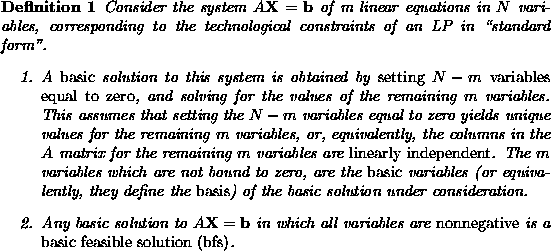For LP's in ``standard form'' the previous characterization of extreme points as the solution of n linearly independent binding constraints, which is, furthermore, a feasible point, can become even more concise. Consider, for instance, the LP
![]()
with m technological constraints and n variables. In ``standard form'', it becomes:
![]()
where I is the ![]() identity matrix, and
identity matrix, and ![]() is the vector of slack variables. It is
interesting to notice that for every binding constraint from the m+n
constraints of the original formulation (Eq. 25), one of
the m+n variables of the ``standard form'' formulation must be equal
to 0. Specifically, if the i-th technological constraint is binding,
the corresponding slack variable
is the vector of slack variables. It is
interesting to notice that for every binding constraint from the m+n
constraints of the original formulation (Eq. 25), one of
the m+n variables of the ``standard form'' formulation must be equal
to 0. Specifically, if the i-th technological constraint is binding,
the corresponding slack variable ![]() . Similarly, if one of the
sign restriction constraints is binding, then the corresponding
varialbe
. Similarly, if one of the
sign restriction constraints is binding, then the corresponding
varialbe ![]() . Since an extreme point of the feasible region of
formulation 25 requires n binding constraints for its
definition, it follows that n from the n+m variables in the
corresponding solution of the ``standard form'' formulation
(Eq. 26) must be equal to zero. Furthermore, since this
point is uniquely defined, the system of equations defined by the m
technological constraints in the ``standard form'' formulation and the
m remaining variables, must have a unique solution. In other words,
the columns of the ``standard form'' formulation corresponding to
these m variables must be linearly independent (and their
determinant must have a nonzero value). Finally, since the extreme
point considered belongs in the feasible region of the problem, it
follows that the unique solution of the aforementioned system of m
equations in the m nonzero variables must be nonnegative (to meet
the sign restrictions required by ``standard form'').
. Since an extreme point of the feasible region of
formulation 25 requires n binding constraints for its
definition, it follows that n from the n+m variables in the
corresponding solution of the ``standard form'' formulation
(Eq. 26) must be equal to zero. Furthermore, since this
point is uniquely defined, the system of equations defined by the m
technological constraints in the ``standard form'' formulation and the
m remaining variables, must have a unique solution. In other words,
the columns of the ``standard form'' formulation corresponding to
these m variables must be linearly independent (and their
determinant must have a nonzero value). Finally, since the extreme
point considered belongs in the feasible region of the problem, it
follows that the unique solution of the aforementioned system of m
equations in the m nonzero variables must be nonnegative (to meet
the sign restrictions required by ``standard form'').
The structure of the ``standard form'' solutions corresponding to
extreme points of the original feasible region (i.e., that defined
with respect to the primary LP variables ![]() ), described for the
example above, actually applies to any other LP in ``standard
form''. We formally characterize this structure through the definition
of basic feasible solutions for LP's in ``standard form'' (taken
from Winston, ``Introduction to Mathematical Programming'').
), described for the
example above, actually applies to any other LP in ``standard
form''. We formally characterize this structure through the definition
of basic feasible solutions for LP's in ``standard form'' (taken
from Winston, ``Introduction to Mathematical Programming'').
